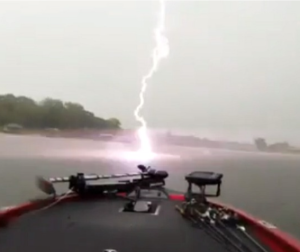A question was posted recently on Reddit Rowing about how thunderstorms are handled in Florida[1] where they seem like a daily occurrence during the summer months. It’s an interesting question and the comments posted ranged from “first signs of lightening, there’s no chance (of rowing)” to “our coach doesn’t care, he pretends it’s only raining even tho (sic) lightning is striking every 20 seconds.” My favorite was “coach usually revs the engine over the thunder and looks away from the lightening. You can’t be sent in for a storm the coach refuses to acknowledge.” That sounds like a fair representation of varying attitudes, but more interesting to me is a comparison of the way we perceive the risks of thunderstorms and cold water and the safety guidance that USRowing offers on both.
USRowing’s guidance on thunderstorms is clear: “Do not row in an electrical storm. Lightning detectors are inexpensive and can clip on your belt. If you are on the water and see lightning, hear thunder, or notice your hair standing on end with static electricity, head for the nearest shore[2]. If the storm is upon you, take your boat ashore and wait for the storm to pass.” Notwithstanding the fact that deaths from lightening strikes are rare, the guidance is responsible, clear, and consistent with all other authorities. Get off the water!
The risks of cold water are similar to those of lightening storms. Most of us have been caught in electrical storms and fallen into cold water and survived unharmed, as the overwhelming number of people do. A much smaller number are struck by lightening or succumb to hypothermia and survive. And some people die. In America the chances of dying from an electric storm in any given year are approximately 1 in 2,000,000[3]. Are the chances of dying from cold shock when rowing on cold water substantially less?
Although USRowing doesn’t cite any rowers’ deaths from lightning, they recommend carrying equipment that warns of the proximity of electrical storms and state flatly “Do not row in an electrical storm.” At the first sign of an electrical storm, “head for the nearest shore.” In contrast, their recommendations for cold water remain vague despite the fact that rowers have died from cold water accidents and the use of the PFDs could have saved those lives.
Fifty years ago the practice of rowing on cold water without PFDs seemed to make sense. Life-jackets were bulky and uncomfortable, and less was known about cold shock. Nor was rowing out of step with the safety consciousness of other sports: football players didn’t wear face masks and hockey players didn’t helmets. Helmets for cycling and skiing hadn’t even been developed.
Today, however, hockey helmets and football facemasks are mandated at virtually all levels of the sport; cycling helmets are mandated in professional competition, twenty-two states, and more than two hundred local jurisdictions, and it is estimated that the majority of skiers and snowboarders in the US and Europe now wear helmets, despite the absence of legal requirements or solid risk reduction data.
Obviously it can be argued that the helmets are bulky, uncomfortable, expensive and unnecessary — and there was initial resistance to wearing them for those reasons — yet the number of deaths that preceded their acceptance in those sports was fewer than the number of deaths that have occurred in rowing from cold water.
Lightning isn’t the only risk to rowers and detectors aren’t the only safety equipment available to rowers. Inexpensive thermometers can tell you exactly how cold the water is, and today’s inflatable PFDs are lightweight and can be worn comfortably under rowing jackets. They don’t chafe, they don’t interfere with a perfect stroke or a full recovery, and they aren’t expensive in relation to unis or racing jackets. Why are we so cautious about lightning and so casual about cold water when cold water has claimed more rowers lives than lightening strikes?
Rowing through the raindrops,
Marc
_________________________________________________________
note: the picture is from a video available on Youtube: https://www.youtube.com/watch?v=uQ87EUe8Z_M
[1] Another interesting aspect of the available data is that most deaths in the US involved water-related activities and “many victims were (apparently) either headed to safety at the time of the fatal strike or were just steps away from safety.” (http://www.lightningsafety.noaa.gov/resources/RecentLightningDeaths.pdf)
[2] USRowing, Safety Guidelines, “On the Water”, 3e
[3] Florida does, in fact, lead the nation in both the number of fatalities from lightening and ranks very high among US states in the number of deaths per million, according to the National Lightening Safety Institute (http://www.lightningsafety.com/nlsi_lls/fatalities_us.html)

